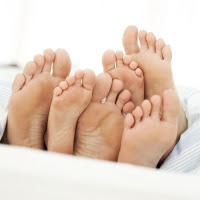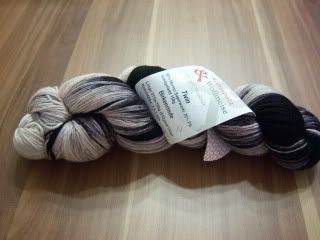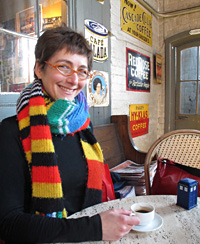In follow up to my last two posts, the toe-up and the top-down training socks, I thought I'd tackle some questions I get asked often.
Of the two methods for knitting socks, top-down vs. toe up: Which should I do first?Which is easier? Which is better?
Which should I do first? I like to recommend new sock knitters start with a top-down sock, for the simple reason that the start is easier.
Which is easier? Hmmm... a tough one to answer. They both have their tricky bits: the toe of a toe-up sock can be fiddly, and the gusset pickup can be challenging for a top-down sock. In either case, don't believe what the muggles says - the heel is not the hardest part, in either case! As long as you have the right number of stitches, and you follow the instructions precisely, the heel is easy! Honestly, they are about equivalent in overall difficulty level.
Which is better? The easy answer to this is, simply, whichever one you like knitting best. They both have their pros and cons, and their defenders and detractors.
TOE UPReasons to be excited:
If you're worried about running out of yarn, working toe-up is the answer. As long as you've got enough yarn to get past the heel, you can just work the leg until you run out. Divide up the yarn evenly into two balls, and you can use up every last yard of each.
Things to be aware of:
Toe-up socks demand special cast-ons and cast offs. None of them are difficult, but make sure that you have access to your favourite resources (books or the internet) as you work. That is, don't do what I did, and attempt to knit your first toe-up sock on a 5 hour flight without any reference books.
There are two types of toe-up heels: with and without a gusset. A gusseted sock tends to fit most feet better, because it adds fabric around the arch of your foot. A non-gusseted sock fits best on a foot with a flatter arch. I use a gusset in my toe-up socks, as does the goddess mother of the toe-up sock,
Wendy D. Johnson. I would recommend you look for toe-up sock patterns that do have a gusset.
TOP DOWN
Reasons to be excited:
Top-down is the "traditional" and therefore more common way to knit socks, and there are more top-down sock patterns out there. (This is changing over time, but many of the masters - Ann Budd, Nancy Bush, Cookie A., Hunter Hammersen - design top-down.)
I've published a lot of very cool top-down sock patterns... :-)
Things to be aware of:
You have to pick up stitches. This terrifies some people. Again, it's not difficult, but make sure you have reference material handy if you are uncertain about how to do it.
You do need a stretchy cast-on. Long tail works brilliantly.
ON THE QUESTION OF FITTING
This is a bigger discussion. Some sock knitters feel that it's easier to custom-fit a toe-up sock. I'll address this in a later post.
REGARDLESS....
No matter which you do first, I highly recommend you try both constructions to see which you enjoy, and to see which fits you best.
NEXT STEPSOnce you've tried the top-down training sock, consider my Basic Ribbed Sock pattern - free from Ravelry:
download now. It's designed to be very accessible to newer sock knitters.
And once you've got the hang of the toe-up training sock, try Deb Barnhill's Back to Basics toe-up pattern from Knitty,
here. It's terrific, well-written, and very accessible.
And re: whether to knit socks on DPNs, magic loop or two circulars: work with what you know! I don't recommend trying to learn a new type of needle setup at the same time as you're trying to learn sock knitting.
Once you're comfortable with socks, then experiment with different needle configurations to see which you like best.
And then once you've figured that out, then try two at once.















 And if you can talk your friends and family into letting you measure their feet, we’d love that info too.
And if you can talk your friends and family into letting you measure their feet, we’d love that info too.

